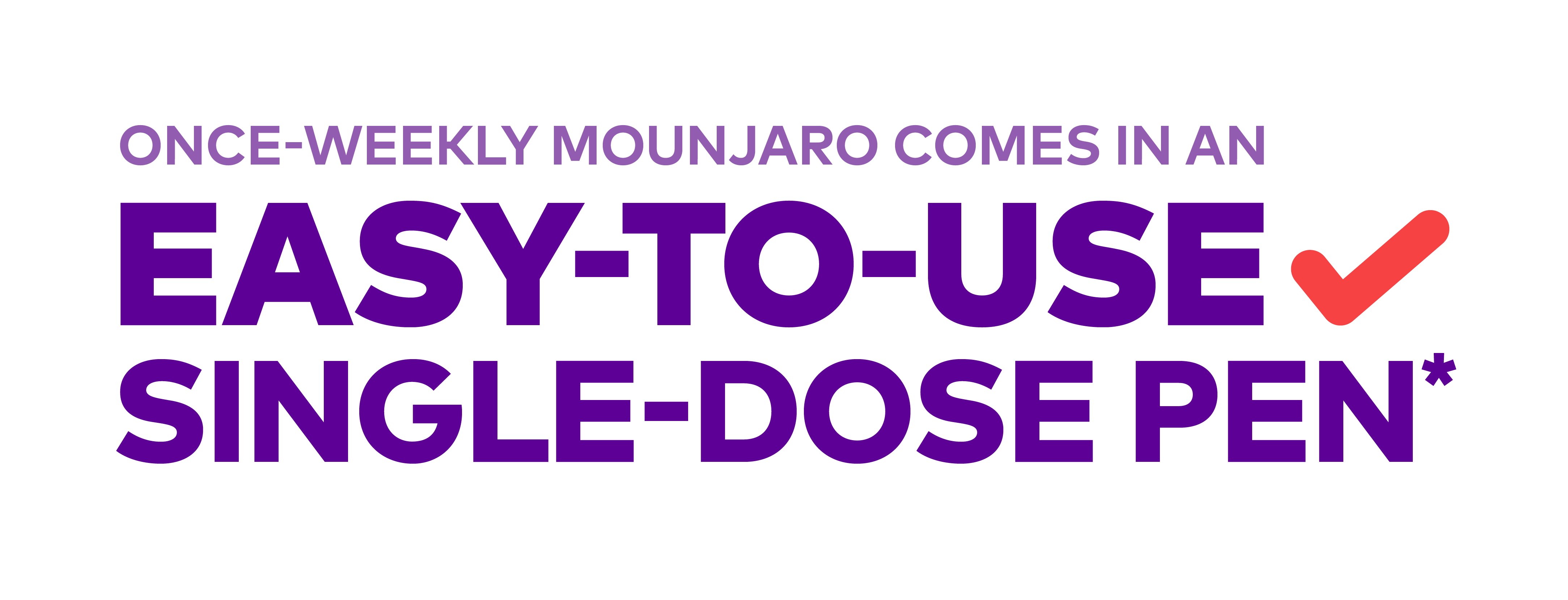
How to use Mounjaro
See how to use Mounjaro
Get all of the details in our video below and in the Instructions for Use.
[AVO]
Mounjaro is an injectable prescription medicine that is used along with diet and exercise to improve blood sugar (glucose) in adults with type 2 diabetes mellitus.
- It is not known if Mounjaro can be used in people who have had pancreatitis.
- Mounjaro is not for use in people with type 1 diabetes.
- It is not known if Mounjaro is safe and effective for use in children under 18 years of age.
Tell your health care provider if you get a lump or swelling in your neck, hoarseness, trouble swallowing, or shortness of breath. These may be symptoms of thyroid cancer. In studies with rats, Mounjaro and medicines that work like Mounjaro caused thyroid tumors, including thyroid cancer. It is not known if Mounjaro will cause thyroid tumors, or a type of thyroid cancer called medullary thyroid carcinoma (MTC) in people. Do not take Mounjaro if you or any of your family have ever had MTC or if you have an endocrine system condition called Multiple Endocrine Neoplasia syndrome type 2 (MEN 2).
See Indication and Safety Summary with Warnings at the end of this video.
[VO Julia]
[SFX: Light samba music plays.]
Hi there! If you're watching this video, you want to know how to take once-weekly Mounjaro.
I'm going to show you how to store Mounjaro, how to check it before taking it, and the 4 steps for administering your weekly dose.
I'll also talk about how to safely dispose of used Mounjaro pens and the importance of weekly reminders.
Read the Instructions for Use that came with your pen. You can also review the 4 injection steps on Mounjaro.com.
Now, if you're about to start taking once-weekly Mounjaro, you've probably been trying to get those A1C numbers down, like me.
And also, the numbers on the scale... I know that struggle.
That's why my doctor prescribed Mounjaro to help manage my type 2 diabetes by lowering my blood sugar.
Mounjaro is a once-weekly injectable medicine that comes in a single-dose pen.
It's not insulin. And I can take it with or without food.
Mounjaro can cause side effects.
The most common side effects reported by patients were nausea, diarrhea, decreased appetite, indigestion, vomiting, constipation, and stomach pain.
Talk to your doctor about any side effects you have.
And, make sure to stick around for the full important safety information at the end of this video.
Now let's take a closer look at the pen and how to use it.
[SFX: Phone rings.]
And that's my reminder.
I set it so I don't forget to take my weekly dose.
Your reminder style is up to you - the important thing is having one in place.
Because, sometimes the everyday can get overwhelming, right?
Although I can take my dose whenever I want on my scheduled day, I try to take it at the same time.
It may make it easier to know what to do if you miss a dose...
If you DO miss a dose, and it's been less than 4 days (96 hours), take your dose as soon as possible.
You can take your next dose as usual.
If it's been more than 4 days (96 hours), skip that dose.
Administer your next dose on your next regularly scheduled day.
But now I want to help you get familiar with the pen...
This is the base cap - it stays on until right before I inject.
And it's kept in the locked position, too.
There's a clear window, so I can see the medicine.
But where's the needle, you ask? Tucked inside, where I never have to see it.
When it's time to take my weekly dose, I need to double-check a few things first.
It's important to make sure you've got the right medicine and dose and that the medicine hasn't expired. Make sure the pen isn't damaged, too.
I also need to check that the medicine is not frozen, not cloudy, not discolored, and does not have particles.
Now, I have to decide where to inject.
I have options. I can administer it to my belly - at least 2 inches away from the belly button - or the tops of my thighs.
I can also use the back of my upper arms. And if I need it, I can have someone help me inject.
If I want, I can use the same area of my body every week. I just need to make sure not to inject in the exact same spot.
A good guideline is to have your next injection site be at least 1 inch away from your last one.
And right before injecting, I wash my hands.
Then, it's Pull, Place, and Press.
First, when the pen is locked, I pull straight down to remove the gray cap. Throw the cap away and don't ever try to put it back on.
And, don't touch the needle.
Next, I place the base flat against my skin, then unlock.
And, the last step: I press and hold the purple button for up to 10 seconds. The first click means that the injection has started. There's another click when it's done.
I know the injection is complete when the gray plunger is visible.
And... the injection is done!
Always dispose of the used pen in a sharps container. And keep the sharps container in a safe place, away from kids and pets.
Don't ever throw pens in household trash, or recycle the used sharps container.
With the Mounjaro Pen, I can take my once-weekly dose at home, or bring it with me for a last-minute getaway.
The pen can remain at room temperature for up to 21 days. But keep it in its original carton, and out of direct heat and sunlight.
So let's recap: Store your medicine in the fridge, and check it before you take it.
Wash your hands, then follow the 4 steps to administer your weekly dose.
Dispose of the pen safely and make sure you've got a reminder in place for next week's dose.
Getting my blood sugar under control is important to me. That's why my doctor and I decided on Mounjaro.
If you have any questions about treatment with Mounjaro, check out Mounjaro.com, and talk to your doctor.
And don't go away! Stay tuned for the full Important Safety Information.
Thanks for watching! Hon, I'm coming!

*Before using the Mounjaro Pen, read the accompanying Instructions for Use (IFU) or watch how to use the Mounjaro Pen at www.mounjaro.lilly.com. In a study of adults with type 2 diabetes for another medicine that uses the same single-dose pen as Mounjaro, 99% said that, after adequate training, the single-dose pen was easy to use. Instructions for Use for the Mounjaro single-dose pen differ from the Instructions for Use provided in the study.

Take Mounjaro once a week
Pick your day.
Use Mounjaro 1 time each week, at any time of the day.
But we know schedules can change. If you want to change the day of the week you take your dose, make sure there are at least 3 days (72 hours) between doses.
If you miss a dose of Mounjaro, take the missed dose as soon as possible within 4 days (96 hours) after the missed dose. If more than 4 days have passed, skip the missed dose and take your next dose on the regularly scheduled day. Do not take 2 doses of Mounjaro within 3 days of each other.
It may be helpful to set a reminder in your phone so you don't forget which day is your Mounjaro day. If you set a reminder and decide to change your day, then don't forget to update your reminder to your new day.
Mounjaro comes in a single-dose pen that requires no mixing.
There is no need to see or handle the needle.†
†Read the Instructions for Use included with your pen.
Follow these 4 steps to use your Mounjaro pen:

Choose your injection site. Your health care provider can help you choose the injection site that is best for you. You or another person can inject the medicine in your stomach, thighs, or the back of your upper arms. Another person should give you the injection in the back of your upper arm.

Pull off the base cap.

Place the base flat on your skin, then unlock.

Press and hold the button for up to 10 seconds. Listen for the first click. It means the injection has started. The second click means that the injection is complete.‡
‡These are not the complete instructions for using Mounjaro. Before starting Mounjaro, your health care provider should show you how to use the pen. Read the Instructions for Use included with your pen.
Select Safety Information
Gallbladder problems. Gallbladder problems have happened in some people who use Mounjaro. Tell your health care provider right away if you get symptoms of gallbladder problems, which may include pain in your upper stomach (abdomen), fever, yellowing of skin or eyes (jaundice), and clay-colored stools.
How to store your Mounjaro pens
Keep Mounjaro in the refrigerator
- Make sure the temperature is between 36°F to 46°F (2°C to 8°C)
- Store the pens in the original packaging to protect your pen from light
- Do not freeze the Mounjaro pens
- The pen has glass parts. Handle it carefully. If you drop the pen on a hard surface, do not use it. Use a new pen for your injection
- Keep in mind, some refrigerators can be colder near the back than on the front/on the door
- Always check your pen to ensure it's not frozen before using it
Going on a trip?
Mounjaro can last unrefrigerated for up to 21 days. Just make sure the temperature does not get any higher than 86°F (30°C). Keep your pen in its original carton to protect your pen from light.

How to dispose of your used Mounjaro pens
It is important to dispose of your pens safely. To do this, put your pen in an FDA-cleared sharps disposal container right away after use. Do not throw away pens in household trash. If you don't have an FDA-approved sharps container, use a household container. Make sure it is made of heavy-duty plastic with a puncture-resistant lid, and it is upright, stable, leak resistant, and properly labeled to warn of hazardous waste.
Keep the container out of the reach of children. Do not recycle your sharps container, follow your community guidelines for the right way to dispose of your sharps disposal container.
Want to know how Mounjaro can help you manage type 2 diabetes?
SEE THE RESULTSWhat is Mounjaro?
Mounjaro is an injectable prescription medicine that is used along with diet and exercise to improve blood sugar (glucose) in adults with type 2 diabetes mellitus.
It is not known if Mounjaro can be used in people who have had pancreatitis. Mounjaro is not for use in people with type 1 diabetes. It is not known if Mounjaro is safe and effective for use in children under 18 years of age.
Once-weekly Mounjaro has multiple dose options
Mounjaro has different dose options, allowing you and your doctor to find the one that's right for you. If your doctor has prescribed once-weekly Mounjaro, you'll start with 2.5 mg. After 4 weeks, you'll move on to 5 mg.§
§Mounjaro should be used once every week. Please consult your doctor with any questions you may have about your Mounjaro prescription.

What happens next?
Let your doctor know how you're doing on the 2.5-mg and 5-mg doses during your checkup. Once you reach 5 mg, your doctor may keep you at the same dose for longer than 4 weeks. You'll work together to decide if your dose needs to be increased beyond 5 mg.

Additional dose increases may occur depending on your doctor's recommendation. After reaching a dose of 5 mg, your dose can increase up to 7.5-mg, 10-mg, 12.5-mg, and 15-mg. You will stay on your current dose for at least 4 weeks.
Tip: Set a reminder to make sure you pick up your next dose
Managing possible side effects
Talk to your doctor if you have any side effect that bothers you or does not go away.
Everyone can have a different experience, but here are the most common side effects experienced by patients taking Mounjaro:
- Nausea
- Diarrhea
- Decreased appetite
- Vomiting
- Constipation
- Indigestion
- Stomach Pain
In studies, most nausea, vomiting and diarrhea events occurred while the dose of Mounjaro was being increased. These events decreased over time.
In studies, GI side effects were more common in people taking Mounjaro than people taking placebo, and people taking Mounjaro were more likely to stop treatment because of these side effects.
Select Safety Information
Kidney problems (kidney failure). In people who have kidney problems, diarrhea, nausea, and vomiting may cause a loss of fluids (dehydration), which may cause kidney problems to get worse. It is important for you to drink fluids to help reduce your chance of dehydration.
Severe stomach problems. Stomach problems, sometimes severe, have been reported with Mounjaro. Tell your health care provider if you have stomach problems that are severe or will not go away.
If you experience nausea, talk to your doctor. In the meantime, some people find the following tips may help:

Eat smaller meals–try splitting your 3 daily meals into 4 or more smaller ones

Stop eating when you feel full

Avoid fat or fatty foods

Try eating bland foods like toast, crackers, or rice

Questions? Call us.
We know we can't replace the advice of your doctor, but we are here to help any way we can.
If you have additional questions, call us at 1-833-807-MJRO (833-807-6576).

Mounjaro Savings
We want to help. You may pay as little as $25 for a 1-month or 3-month prescription with the Mounjaro Savings Card.* †
*For eligible commercially insured patients with Mounjaro coverage. Governmental beneficiaries excluded, terms and conditions apply.
†One month is defined as 28 days and 4 pens. Three months is defined as 84 days and up to 12 pens.
LEARN MORESubject to Lilly USA, LLC's (Lilly's) right to terminate, rescind, revoke or amend the Mounjaro Savings Card Program (“Card” or “Program”) eligibility criteria and/or Card terms and conditions which may occur at Lilly's sole discretion, without notice, and for any reason, the Card expires and savings end on 12/31/2024. Card savings are not available to patients without commercial drug insurance or who are enrolled in any state, federal, or government funded healthcare program, including, without limitation, Medicaid, Medicare, Medicare Part D, Medicare Advantage, Medigap, DoD, VA, TRICARE®/CHAMPUS, or any state prescription drug assistance program.
MONTHLY AND ANNUAL MAXIMUM SAVINGS: For patients with commercial drug insurance coverage for Mounjaro: You must have commercial drug insurance that covers Mounjaro®(tirzepatide) and a prescription consistent with FDA-approved product labeling to pay as little as $25 for a 1-month, 2-month, or 3-month prescription fill of Mounjaro. Month is defined as 28-days and up to 4 pens. Card savings are subject to a maximum monthly savings of up to $150 per 1-month prescription, $300 per 2-month prescription, or $450 per 3-month prescription fill and separate maximum annual savings of up to $1800 per calendar year. Card may be used for a maximum of up to 13 prescription fills per calendar year. Subject to Lilly USA, LLC's ("Lilly") right to terminate, rescind, revoke, or amend Card eligibility criteria and/or Card terms and conditions which may occur at Lilly's sole discretion, without notice, and for any reason, Card expires and savings end on 12/31/2024.
For patients with commercial drug insurance who do not have coverage for Mounjaro: You must have commercial drug insurance that does not cover Mounjaro and a prescription consistent with FDA-approved product labeling to obtain savings of up to $573 off your 1-month prescription fill of Mounjaro. Month is defined as 28-days and up to 4 pens. Card savings are subject to a maximum monthly savings of up to $573 and a separate maximum annual savings of up to $3,438 per calendar year. Card may be used for a maximum of up to 6 prescription fills per calendar year. Subject to Lilly's right to terminate, rescind, revoke, or amend Card eligibility criteria and/or Card terms and conditions which may occur at Lilly's sole discretion, without notice, and for any reason, Card expires and savings end on 12/31/2024.
ADDITIONAL TERMS AND CONDITIONS:
You are responsible for any applicable taxes, fees and any amount that exceeds the monthly or annual maximum benefits. Savings card activation
is required. This Card may be terminated, rescinded, revoked, or amended by Lilly at any time without notice and for any reason. Subject to
additional terms and conditions. Eligibility criteria and terms and conditions for the Mounjaro Savings Card Program may change from time to
time at Lilly's sole discretion and for any reason; the most current version can be found at
https://www.mounjaro.lilly.com/savings-resources#savings.
Card benefits void where prohibited by law.